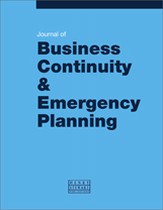The capability and constraint model of recoverability: An integrated theory of continuity planning
Abstract
While there are best practices, good practices, regulations and standards for continuity planning, there is no single model to collate and sort their various recommended activities. To address this deficit, this paper presents the capability and constraint model of recoverability — a new model to provide an integrated foundation for business continuity planning. The model is non-linear in both construct and practice, thus allowing practitioners to remain adaptive in its application. The paper presents each facet of the model, outlines the model’s use in both theory and practice, suggests a subsequent approach that arises from the model, and discusses some possible ramifications to the industry.
The full article is available to subscribers to the journal.
Author's Biography
David Lindstedt is a frequent contributor to the Journal of Business Continuity and Emergency Planning and has presented at numerous local and international conferences. He is the founder of Readiness Analytics and creator of software to measure disaster preparedness. His most recent efforts focus on establishing a foundation for Continuity 2.0.
Citation
Lindstedt, David (2017, September 1). The capability and constraint model of recoverability: An integrated theory of continuity planning. In the Journal of Business Continuity & Emergency Planning, Volume 11, Issue 1. https://doi.org/10.69554/DWVC9236.Publications LLP
